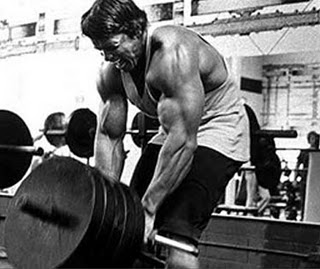I remember my early years of training in a public/commercial gym after graduating college. It was the mid-90’s, and I was trying to figure out the truth about training, diet and supplements. This journey included a lot of trial-and-error, not to mention wasted money (the before-mentioned supplements).
There’s this one guy I’d see in the gym almost every time I worked out. We became friends, and I learned that he normally trained six days a week. He had a good physique, but I began noticing something over the months and years: he never really got bigger, stronger, or leaner. He pretty much used the same weights, same exercises, and had the same look week after week.
As I said, he was strong and muscular. But I suspect he could have maintained his physique with much less time in the gym.
This guy actually ended up with a pretty serious back injury that sidelined his training. I can’t remember if he was injured at work or in the gym. But now I wonder if overtraining had something to do with it (or overusing the same exercises). I’m not sure if he ever really recovered.
I’m hoping to make a point with all the introductory rambling—I’d like to share some  thoughts about training intensity.
thoughts about training intensity.
Transforming your physique is hard work, and there is some truth to the “no pain, no gain” cliché. But over the years I’ve learned there is something more important than training hard: training smart.
I first learned this lesson when I reached a plateau in my strength gains. The problem wasn’t lack of effort but lack of knowledge. That’s when I discovered periodization, a system used by powerlifters to develop maximum strength.
Years later I learned about deloading—intentionally lifting lighter weights for a week (or taking a week off altogether).
Both of these strategies are intentional adjustments in training intensity—backing off for the sake of better long-term gains.
I’ve taken these principles a little further in my own training philosophy. Here’s what I mean: I think trainees tend to be in either maintenance phase or transformation phase.
Transformation phase means either getting bigger, stronger, or leaner (or a combination of all three). Maintenance phase means doing sufficient training to keep the progress you’ve made (or keep most of it), but no more.
Here’s how it has played out for me lately:
I’m finishing up an 8-week training cycle. I’ve been lifting four days a week, which is the highest training volume I’ve done in years (I normally train only three times a week). This is the biggest and leanest I’ve been in quite some time (implementing the principles of the Renegade Diet has been very helpful).
This cycle came after about three months of bare-minimum, maintenance training. I was lifting only about twice a week from January through April. Working out wasn’t my top priority because I got married in March.
That period of maintenance training was really good for me. I didn’t make any gains, of course, but I was ready for the phase I’m in right now—I went into it with more enthusiasm and focus than I’ve had in a long time. Lowering the intensity/volume, even for several weeks, was very helpful in the long run.
Here’s where I’m going with all this:
I wonder if some of us would get better results by really focusing on diet/training for a few months (transformation phase), achieving the desired result, then backing off (maintenance phase).
This, after all, is how most elite athletes seem to do it: they get themselves in peak condition for some kind of competition (or a whole season), then rest. Maybe some of us never really peak or rest, instead settling for a mediocre level of intensity year-round.